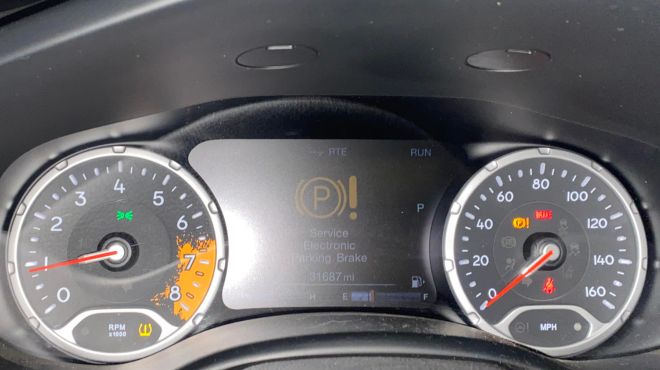Seeing the dreaded “Service Electronic Parking Brake” warning suddenly pop up on your car’s dashboard display can make your heart skip a beat.
Electronic parking brakes (EPBs) are increasingly common in modern vehicles. Rather than a manual handbrake, EPBs rely on an electric motor and calipers to automatically engage the parking brake when you shift into Park or power off the vehicle. This frees up space in the center console and enables features like auto brake hold.
The Service Electronic Parking Brake warning light can be triggered by a variety of issues like a faulty switch, stuck brake, bad motor, wiring problems, software bugs, low voltage, insufficient brake fluid, or faulty sensors. Carefully diagnosing the specific fault and making repairs is required to get the EPB system working properly again and turn the warning light off.

Identifying the specific cause for the service electronic parking brake warning is key to the right repair. This post will walk through the most common issues, starting with the simplest fixes first to get your electronic parking brake back in working order.
What Does the Service Electronic Parking Brake (EPB) Warning Light Actually Mean?
When the parking brake service warning illuminates in your Jeep’s dashboard, it’s the car’s way of telling you there’s an issue with the electronic parking brake system that requires attention.
Don’t assume it automatically means you’re facing a huge repair bill or catastrophic failure though. In most cases, it’s alerting you to a relatively minor problem that simply needs to be diagnosed and addressed.
Think of it like the “Check Engine” light. It’s notifying you that one of the EPB components needs service, but not that you’re dealing with a major crisis.
However, it’s very important not to ignore the EPB warning light when it comes on. If the underlying problem isn’t repaired, it can lead to bigger issues down the road, including getting stranded with a parking brake that won’t disengage.
The warning light is designed to grab your attention so you can address problems promptly before they worsen. So take it seriously and begin troubleshooting as soon as possible. With the right information and some basic tools, you can usually get the light turned off and have your EPB fully functional again.
This is a common issue in Jeep models like Jeep Compass and Jeep Renegade. So, if you are not comfortable on working out the issue on your own, you can visit your dealership and diagnose the issue.
Most Common Causes of the Service Electronic Parking Brake Warning (In Order)
When that dreaded parking brake service light pops up, what’s triggering it? Here are the most common issues that can activate the warning light, starting with the simplest, most likely culprits:
1. Faulty or Dirty EPB Switch
The most common cause of the parking brake service light is a malfunctioning or dirty EPB switch.
The EPB switch is what activates the electric motor to engage the parking brake when you shift into Park. It’s a simple mechanical switch that should click cleanly on and off as you shift in and out of Park.
If the switch becomes contaminated with dirt, sticky soda, grease or other gunk, it may not make solid contact when shifting. This tricks the EPB computer into thinking there’s a problem, causing the warning light.
The fix here is very simple – thoroughly clean the EPB switch. Spray it out with electrical contact cleaner or brake parts cleaner. Let it sit for 5 minutes then press the switch repeatedly to work the cleaner in. This will usually have your EPB switch clicking cleanly in no time so you can stop the warning light.
2. Trapped or Locked Electronic Parking Brake
Another common culprit behind the Service Electronic Parking Brake warning is when the electronic parking brake gets stuck partially engaged and won’t fully release. This leaves it in a locked state, causing the warning light to activate.
This can happen for a few reasons – a software glitch, bad EPB motor, or mechanical binding. Whatever the cause, the solution is to fully release the trapped EPB manually using the emergency release lever.
Every EPB system has a manual release mechanism in case the electronic motor fails. It’s usually located under or near the glovebox. Refer to your owner’s manual for the specific location.
To manually release a stuck EPB, simply pull firmly on the release lever. You’ll likely hear a click or clunk sound as the brake releases.
With the EPB manually unlocked, you can now shift out of Park and drive normally. The warning light should also turn off. You can then diagnose why it got stuck in the first place and repair accordingly. But the release lever is a quick way to get rolling again.
3. Damaged or Failed EPB Motor
The electronic parking brake relies on a small electric motor to engage and disengage the brake. If this motor is damaged or burns out, it can trigger the EPB warning light.
Symptoms of a failed EPB motor include the parking brake not releasing, not engaging, or making grinding noises during operation.
To troubleshoot a problematic EPB motor:
- Visually inspect the motor for signs of damage like cracked housings, worn gears, or binding.
- Check for dirt buildup around the motor that could cause poor operation. Clean carefully using brake or electrical cleaner.
- Test the motor by connecting it to a power source. If it doesn’t run at all, it likely needs to be replaced.
- Ensure proper voltage is reaching the motor by testing the wires and connections.
Replacing a burned out or damaged EPB motor will typically make the parking brake fully functional again and turn off the warning light. Consult your repair manual for proper replacement procedures.
With some diligence, you can identify and fix EPB motor issues and have your parking brake working properly again quickly.
4. Faulty Wiring
Like any electrical component, the EPB system relies on good wiring and connections to operate properly. Frayed, corroded, or loose wires can interfere with power getting to the EPB motor and cause malfunctions.
Some things to inspect in the EPB wiring:
- Rubbing or bare spots in the cables that expose copper. Electrical tape can temporarily insulate small areas of damage.
- Corroded or loose connectors that disrupt power flow. Clean with electrical contact cleaner or replace damaged connectors.
- Areas where wires may have been pinched or chafed. Inspect under the console and along the floors.
- Voltage at the EPB motor itself during operation. Use a multimeter to check for power drops.
- The EPB fuse in the fuse panel. A blown fuse can cut power.
Methodically inspecting the wiring system from the EPB switch back to the motor is key to finding interruptions in power flow. Make repairs as needed to get full voltage flowing smoothly again.
Pro tip: Always disconnect the battery before doing EPB wiring repairs to avoid shorts!
With the wiring fixed, the EPB will function normally again and the warning light will turn off.
5. Outdated or Buggy Electronic Parking Brake Software
The electronic parking brake is controlled by onboard computer software that can encounter glitches or become outdated just like any other computer program. Software bugs and errors in the EPB programming can sometimes erroneously trigger the parking brake service light.
To troubleshoot software issues:
- Have your mechanic scan for any diagnostic trouble codes stored in the EPB module that may point to specific software faults.
- Ask your dealer to check for and install the latest EPB control module software updates which may fix buggy code.
- As a quick fix, try disconnecting the battery for 15 minutes to reset the EPB computer and restart it with a clean slate.
- In rare cases, the EPB module may need to be replaced if it’s damaged or severely corrupted.
Software gremlins can be tricky to diagnose without mechanic scan tools. But fixing coding errors and glitches can get your EPB functioning normally again and switch off that pesky warning light.
6. Low Battery or Electrical Voltage Issues
The electronic parking brake needs adequate battery and electrical system voltage to operate properly. A weak battery, dirty terminals, or bad alternator can impact voltage reaching the EPB motor and trigger the service electronic parking brake warning light.
Some ways to troubleshoot voltage issues:
- Use a multimeter to check battery and system voltage. It should be 12+ volts with engine running. Consistently low readings indicate an issue.
- Try jump starting the vehicle from another car or battery booster pack. If EPB starts working normally, low battery is likely the culprit.
- Inspect battery terminals for heavy corrosion buildup which resists power flow. Clean terminals can greatly help connectivity.
- Wiggle battery cables while engine is running. If EPB warning comes on, there’s likely a loose terminal or wiring connection.
- Test alternator belt tension and output. A faulty alternator can cause insufficient charging to the battery.
Maintaining a properly charged battery with clean connections is key to ensuring adequate voltage to all electronics like the EPB. Resolving electrical issues can return it to smooth operation.
7. Low Brake Fluid
Since the electronic parking brake uses the standard hydraulic brake calipers to engage, low brake fluid can also trigger the service electronic parking brake warning light in some vehicles.
When brake fluid drops below the minimum level in the master cylinder reservoir, it sets off a sensor that lights up the parking brake service warning.
The fix here is straightforward – simply locate the brake fluid reservoir under the hood and top it off to the “Full” mark using the recommended DOT3 or DOT4 brake fluid. Take care not spill any brake fluid on painted components as it can damage finishes.
With the brake system replenished, the parking brakes will have adequate hydraulic pressure to operate again. Make sure to also inspect brake pads/rotors and watch for any leaks that may have caused the low fluid level.
Maintaining proper brake fluid level is important for safe, reliable braking as well as smooth EPB operation. Check it periodically as part of routine vehicle maintenance.
8. Faulty EPB Sensors
The electronic parking brake relies on various sensors to monitor the position and operation of the system. Issues with these sensors can activate the EPB warning light.
Some key sensors include:
- Parking brake switch – Senses when EPB is engaged. Dirty or faulty contacts may not register properly.
- Parking brake position sensor – Tracks where caliper arms are. Bad data can trigger light.
- Wheel speed sensors – Compare front/rear wheel speeds to detect drag. Faults can cause false warnings.
- Brake fluid level sensor – Tripped by low brake fluid as mentioned previously.
Diagnosing bad EPB sensors usually requires professional scan tools to check for diagnostic trouble codes and test sensor outputs. But some basic checks include:
- Visually inspect sensors for damage or dirt buildup. Clean gently with electrical contact cleaner.
- Verify connectors are fully locked and free of corrosion.
- Watch for related transmission or ABS trouble lights which share some sensors.
- Test continuity through sensors with a multimeter. Refer to specs but 0-2 ohms is typical.
Replacing malfunctioning EPB sensors based on scan tool data is typically required to restore normal operation and extinguish the parking brake warning light.
Handy Troubleshooting Tips for EPB Problems

Here are some handy pro tips for diagnosing and repairing electronic parking brake issues:
Always disconnect the battery before doing any EPB work. This avoids accidental electrical shorts which can damage components. Park the car, pull the negative terminal, then proceed with EPB repairs.
Follow proper steps when cleaning an EPB switch. Spray cleaner generously into the switch and let it soak for 5+ minutes. Then flip the switch back and forth about 20 times to work the cleaner into the contacts. Let it sit another minute before reconnecting. This helps remove sticky residue.
Inspect the parking brake cables running to the rear calipers as part of troubleshooting. Look for binding or kinks which can prevent smooth operation. Also check for severe corrosion on the cable ends which can cause electrical resistance. Lubricate cables and replace if badly damaged.
Check EPB fuses in the fuse panel if you encounter power problems. Burned out fuses stopping voltage can cause malfunctions. Always use replacement fuses with the proper amp rating to avoid issues.
Use a multimeter to diagnose wiring faults. Check voltage at connectors and track down drops in power due to damaged wiring. Compare left/right readings which should match. This helps pinpoint problem spots.
Consult factory service manuals for EPB diagnostics and reset procedures specific to your vehicle make and model. This provides helpful troubleshooting tips and wiring diagrams.
Equipped with some basic automotive repair knowledge and the right tools, many EPB issues can be resolved with simple DIY troubleshooting. Just take all necessary safety precautions.
How to Reset Electronic Parking Brake?
After you’ve diagnosed and repaired the issue causing your electronic parking brake trouble, you’ll likely need to reset the warning light on the dash to clear it. Here is a typical EPB reset procedure:
- Ensure the parking brake is fully released and make your fix to the EPB system.
- Turn the ignition key to the “On” position but do not start the engine.
- Press and hold the EPB switch button for 10-15 seconds until the warning light blinks rapidly.
- Turn the ignition fully Off then back On again.
- The EPB light should now remain off indicating the reset was successful.
- You can now start the engine and safely resume driving.
- Retest the parking brake function several times to confirm normal operation.
Note that the steps may vary slightly by vehicle make and model. Always check your owner’s manual or factory service info for the correct reset procedure for your EPB system.
Getting the computer to clear the service warning is key to letting you know repairs were effective. Now get back to smooth and confident driving!
Don’t Let the EPB Light Get You Down!
While seeing the service electronic parking brake warning suddenly appear can give you a real scare, in most cases it ends up being an easy fix. Here are some key takeaways:
- The EPB light simply indicates a problem needing attention, not a dire emergency. Stay calm!
- Typical causes include dirty switches, low brake fluid, stuck brakes, electrical issues, and bad sensors.
- Carefully troubleshoot the problem starting with the simplest solutions first.
- Cleaning or replacing faulty parts gets the EPB working again in many cases.
- Always reset the warning light after repairs to confirm it’s fixed.
- Seeking help from a professional mechanic is wise if you’re unsure of diagnostics.
- Stay proactive with EPB maintenance to avoid problems appearing out of the blue.
While electronic parking brakes add great functionality, they do come with some additional complexity. But a bit of DIY troubleshooting knowledge and repair skill can keep your EPB system running smoothly for years.
Let us know if you’ve dealt with a pesky EPB warning light! Share your experience and solution in the comments below to help other readers. And don’t hesitate to ask questions if you need advice about that nagging EPB issue. We’re happy to help get your parking brake working properly again!
Also Read:



